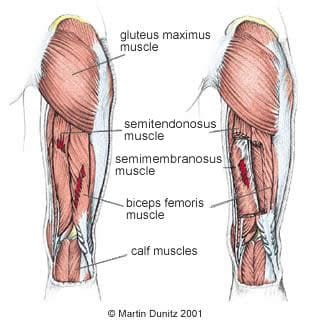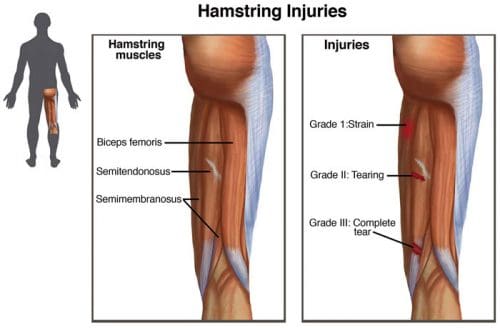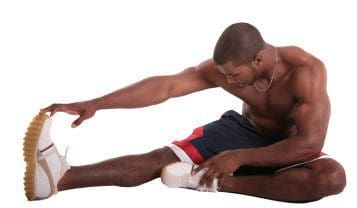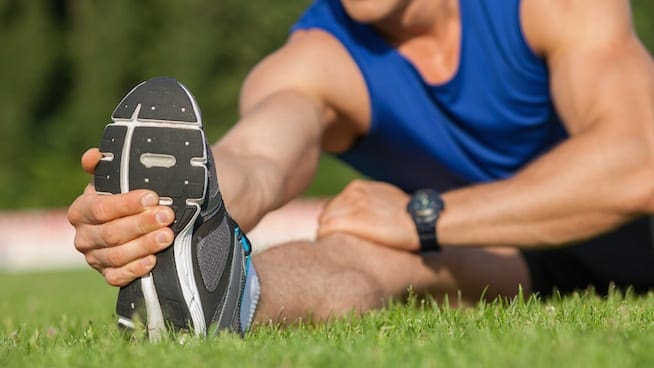Imagine you trained well for a significant race, got yourself into form and cruised through the first half of the course without any issues, and were on pace for a nice PR. All of a sudden, you started to notice tightness in one of your hamstrings. In the beginning, it was a hindrance that could be ignored, but the tightness got steadily worse until your hamstring was a stiff, painful mass of tissue which cried out to cease.
You slowed down, you ceased to stretch, massaged it, but nothing helped. Realizing that this was the conclusion of your race, you limped to the end, disappointed and frustrated that after six months of attentive, time-consuming preparations, some strips of muscular tissue in the back of your thigh had prevented you from attaining your goal. Does this situation sound familiar to someone or has this happened to someone you know?
Contents
Hamstring Injury Issues
Hamstring difficulties are common among runners, with strains, pulls, tendinitis and tears being the most commonly reported damage or injury to the hamstring muscles. Are hamstring issues common? Most distance runners have developed a scenario called “quad dominance,” a scenario that takes place when the quad muscles overpower the action of the hamstrings at the movement of the leg through a running stride.
Logging a great deal of miles on the streets can put repetitive functional overload on the quadriceps, which makes them powerful, strong and dominant. When the quadriceps contract as you land, the hamstrings, the opposite muscles, act as brakes for your knee to stop against hyperextending in the conclusion motion of a stride.

The quad functions when the knee is locked out in expansion with motion happening in the hip (the forward swing of a stride). The quadriceps work along with the hip flexors to flex the hip as you run. In addition, once the hip is fixated with movement taking place in the knee (when the leg is planted on the floor), the quads function as extensors of the knee.
If your hamstrings are significantly weaker than your quads, due to a continuous loading of the anterior (frontal) chain from jogging or running, particularly seen in athletes, then one of two things will happen: first, your hamstrings will tear as a consequence of not being able to take the load created by the contracting quadriceps and momentum out of hip extension; and two, you will run slower as a consequence of diminished power from the hip flexors and knee extensors since the hamstrings have to contract earlier to have the ability to break the ensuing movement.

Regrettably, once you get yourself into this quad-dominating problem, it’s difficult to undo. Hamstring injuries are rather slow to cure, and athletes regularly spend plenty of time resting before they are able to train without much pain towards carrying out activities. However, like muscle injuries, distress tends to return again and again, particularly because most athletes fail to deal with the root cause of their problems.
When the quadriceps are concentrically contracting (as you land), the hamstrings need to be eccentrically contracting to check the movement. It has been proven for producing activities, that contractions will have limited gains in strength. For this reason, focusing upon loading is critical.
By executing a suitable strengthening program for those hamstrings using a series of specific, isolated, and abnormal exercises, such as those in which muscle fibers lengthen because they contract, you can remove the quad dominance, and keep yourself healthy, powerful and quick. It is possible to begin with the following three simple hamstring exercises below to help treat an athlete’s hamstring injuries, improving strength, flexibility and mobility.
Hamstring Exercises
The exercises here will strengthen the hamstrings while the muscles actively lengthen by mimicking the “grab” of a leg’s swing period whilst jogging. Each of these exercises 8 to 12 times for 3 to 4 sets. On moving from the center, focus, and remember that the emphasis is on the portion of the motion.

Good Morning
- A) Start with your thighs locked, arms holding a weight bar on your shoulders with conflicting grasp, back in neutral position and center tight.
- B) Slowly bend over at the waist, gently feeling the stretch on down the road. Keep your chest do not hesitate to droop your shoulders toward the floor in an attempt to seem like you are going . Constantly keep the core to support your back.
- C) On down the road, maintain the barbell as close to your leg as possible to decrease the pressure on the lower spine. Maintain the back at the neutral position.
- D) When you’ve gone as low as possible with your knees locked, start to return up slowly. (Avoid the tendency to jerk upwards or arch your spine. Should you feel inclined to either, use less weight on the bar.)
- E) For a sophisticated version, try this exercise one leg at a time by putting the non-exercising leg up on a seat on your side.
Single-Leg Romanian Dead Lift
- A) Stand holding a barbell in front of you on your right hand, putting your weight in your right foot. Lean forward 15 degrees or so.
- B) Keeping a small bend in your right knee, your back flat and your chest out, lift your left leg straight out behind you as you reduce your body over your right leg. Slide the dumbbell to about mid-shin down your quad and lift your own body back up into an erect posture, keeping your weight onto your right leg. Repeat for 2 to 12 repetitions, then switch hands and legs.
- C) To progress this exercise, stand on a barbell or Bosu with the exact same weight, or stay on the floor and increase your weight.
Eccentric Hamstring Curl (with a partner)
- A) Kneel on a folded towel or a pile of exercise mats with your toes pulled toward your shins. Keep your hands in front of your chest. Your partner sits behind you, facing your spine, pressing down on your legs with his palms.
- B) Keep your core tightup your torso and hips forward so your body forms a straight line from the ears to your knees. As you lower your chest whilst resisting gravity keep this posture. Control the range of motion as far as you can, grab yourself with your hands, then push off the floor in yanking you back up to assist your hamstrings and glutes. (In case you do not have a spouse, you can perform a similar workout on a hamstring washing machine)
The scope of our information is limited to chiropractic and spinal injuries and conditions. To discuss options on the subject matter, please feel free to ask Dr. Jimenez or contact us at 915-850-0900 .�
By Dr. Alex Jimenez
Additional Topics: Sports Care
Athletes engage in a series of stretches and exercises on a daily basis in order to prevent damage or injury from their specific sports or physical activities as well as to promote and maintain strength, mobility and flexibility. However, when injuries or conditions occur as a result of an accident or due to repetitive degeneration, getting the proper care and treatment can change an athlete’s ability to return to play as soon as possible and restore their original health.

TRENDING TOPIC: EXTRA EXTRA: New PUSH 24/7�? Fitness Center
General Disclaimer, Licenses and Board Certifications *
Professional Scope of Practice *
The information herein on "Running Athletes and Hamstring Injuries | El Paso Chiropractor" is not intended to replace a one-on-one relationship with a qualified health care professional or licensed physician and is not medical advice. We encourage you to make healthcare decisions based on your research and partnership with a qualified healthcare professional.
Blog Information & Scope Discussions
Welcome to El Paso's Premier Wellness and Injury Care Clinic & Wellness Blog, where Dr. Alex Jimenez, DC, FNP-C, a Multi-State board-certified Family Practice Nurse Practitioner (FNP-BC) and Chiropractor (DC), presents insights on how our multidisciplinary team is dedicated to holistic healing and personalized care. Our practice aligns with evidence-based treatment protocols inspired by integrative medicine principles, similar to those on this site and on our family practice-based chiromed.com site, focusing on naturally restoring health for patients of all ages.
Our areas of multidisciplinary practice include Wellness & Nutrition, Chronic Pain, Personal Injury, Auto Accident Care, Work Injuries, Back Injury, Low Back Pain, Neck Pain, Migraine Headaches, Sports Injuries, Severe Sciatica, Scoliosis, Complex Herniated Discs, Fibromyalgia, Chronic Pain, Complex Injuries, Stress Management, Functional Medicine Treatments, and in-scope care protocols.
Our information scope is multidisciplinary, focusing on musculoskeletal and physical medicine, wellness, contributing etiological viscerosomatic disturbances within clinical presentations, associated somato-visceral reflex clinical dynamics, subluxation complexes, sensitive health issues, and functional medicine articles, topics, and discussions.
We provide and present clinical collaboration with specialists from various disciplines. Each specialist is governed by their professional scope of practice and their jurisdiction of licensure. We use functional health & wellness protocols to treat and support care for musculoskeletal injuries or disorders.
Our videos, posts, topics, and insights address clinical matters and issues that are directly or indirectly related to our clinical scope of practice.
Our office has made a reasonable effort to provide supportive citations and has identified relevant research studies that support our posts. We provide copies of supporting research studies upon request to regulatory boards and the public.
We understand that we cover matters that require an additional explanation of how they may assist in a particular care plan or treatment protocol; therefore, to discuss the subject matter above further, please feel free to ask Dr. Alex Jimenez, DC, APRN, FNP-BC, or contact us at 915-850-0900.
We are here to help you and your family.
Blessings
Dr. Alex Jimenez DC, MSACP, APRN, FNP-BC*, CCST, IFMCP, CFMP, ATN
email: coach@elpasofunctionalmedicine.com
Multidisciplinary Licensing & Board Certifications:
Licensed as a Doctor of Chiropractic (DC) in Texas & New Mexico*
Texas DC License #: TX5807, Verified: TX5807
New Mexico DC License #: NM-DC2182, Verified: NM-DC2182
Multi-State Advanced Practice Registered Nurse (APRN*) in Texas & Multi-States
Multi-state Compact APRN License by Endorsement (42 States)
Texas APRN License #: 1191402, Verified: 1191402 *
Florida APRN License #: 11043890, Verified: APRN11043890 *
License Verification Link: Nursys License Verifier
* Prescriptive Authority Authorized
ANCC FNP-BC: Board Certified Nurse Practitioner*
Compact Status: Multi-State License: Authorized to Practice in 40 States*
Graduate with Honors: ICHS: MSN-FNP (Family Nurse Practitioner Program)
Degree Granted. Master's in Family Practice MSN Diploma (Cum Laude)
Dr. Alex Jimenez, DC, APRN, FNP-BC*, CFMP, IFMCP, ATN, CCST
My Digital Business Card
Licenses and Board Certifications:
DC: Doctor of Chiropractic
APRNP: Advanced Practice Registered Nurse
FNP-BC: Family Practice Specialization (Multi-State Board Certified)
RN: Registered Nurse (Multi-State Compact License)
CFMP: Certified Functional Medicine Provider
MSN-FNP: Master of Science in Family Practice Medicine
MSACP: Master of Science in Advanced Clinical Practice
IFMCP: Institute of Functional Medicine
CCST: Certified Chiropractic Spinal Trauma
ATN: Advanced Translational Neutrogenomics
Memberships & Associations:
TCA: Texas Chiropractic Association: Member ID: 104311
AANP: American Association of Nurse Practitioners: Member ID: 2198960
ANA: American Nurse Association: Member ID: 06458222 (District TX01)
TNA: Texas Nurse Association: Member ID: 06458222
NPI: 1205907805
| Primary Taxonomy | Selected Taxonomy | State | License Number |
|---|---|---|---|
| No | 111N00000X - Chiropractor | NM | DC2182 |
| Yes | 111N00000X - Chiropractor | TX | DC5807 |
| Yes | 363LF0000X - Nurse Practitioner - Family | TX | 1191402 |
| Yes | 363LF0000X - Nurse Practitioner - Family | FL | 11043890 |








